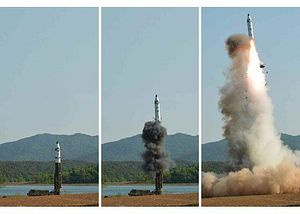North Korea has continued to produce support equipment and launchers for one of its newer ballistic missiles through the first half of 2018, according to a recent U.S. military intelligence assessment described to The Diplomat by U.S. government officials.
According to a recent assessment released by the U.S. National Air and Space Intelligence Center (NASIC), which analyzes intelligence regarding ballistic missile threats for the U.S. Air Force, North Korea has continued to produce vehicles and support equipment for its Pukguksong-2/KN15 medium-range ballistic missile in 2018.
While production of launch vehicles—known as transporter-erector-launchers, or TELs—and support equipment has continued through the first half of 2018, North Korea has likely not produced additional Pukguksong-2 missiles, the assessment notes. North Korea may have produced as many as ten TELs for the Pukguksong-2.
In June 2017, a public NASIC assessment assessed the Pukguksong-2’s range at in excess of 1,000 kilometers. According to that assessment, the missile was not yet deployed then even though North Korean leader Kim Jong Un declared it operational after its second flight test in May 2017.
The missile’s range would leave it best suited for use against targets in Japan, including U.S. military installations on Japan’s four main islands and Okinawa.
The Pukguksong-2 was the first North Korean ballistic missile to feature an indigenously designed and built integrated transporter-erector-launcher with continuous tracks that allow it to conduct launches from unpaved roads and other rough terrain.
This two-stage, solid-fuel missile—first flight-tested in February 2017 and once again in May 2017—is a land-based version of North Korea’s Pukguksong-1/KN11 submarine-launched ballistic missile.
Like the submarine-launched version, the missile is ejected from a canister using pressurized gas—a process known as cold launching—before its main engines ignite in the air. It is North Korea’s first land-based, canisterized, long-range solid-fuel missile.
The recent NASIC assessment does not account for the reason behind North Korea’s move to produce TELs and support equipment, but not the missiles themselves.
The decision to hold off on producing ballistic missiles may be due to the regime’s attempts at pursuing diplomacy with both South Korea and the United States. Alternatively, the nonproduction of missiles may have to do with supply constraints on materials and components.
North Korea has not tested any ballistic missiles in more than seven months, since its test of the Hwasong-15 intercontinental-range ballistic missile on November 28, 2017.
Throughout 2018, U.S. military intelligence has also observed a marked reduction in vehicle movements across known North Korean ballistic missile operating areas, suggesting that the country has put in place restrictions on otherwise normal military movements as it has pursued diplomacy with South Korea and the United States.
Nevertheless, during his New Year’s Day address on January 1 this year, Kim Jong Un had directed the continued production of nuclear warheads and ballistic missiles.
“The nuclear weapons research sector and the rocket industry should mass-produce nuclear warheads and ballistic missiles, the power and reliability of which have already been proved to the full, to give a spur to the efforts for deploying them for action,” Kim had said.
On April 20, at the third plenary meeting of the Workers’ Party of Korea’s 7th Central Committee, Kim directed the closure of the Punggye-ri nuclear test site and announced that North Korea would cease testing intercontinental-range ballistic missiles. He, however, did not reverse his order for the production of new missiles and warheads.
Additionally, while Kim did not announce a testing moratorium, he noted that further flight-testing of North Korea’s intermediate-range ballistic missiles—most likely the Hwasong-12—would also not be required.
Publicly, North Korea has made no concessions related to the testing or production of its medium- and short-range missiles, including the Pukguksong-2, the Nodong, and its several Scud variants.
The United States and North Korea are set to carry out further negotiations on the implementation of the June 12 Singapore joint statement signed by Kim and U.S. President Donald J. Trump. In that statement, North Korea agreed “to work toward complete denuclearization of the Korean Peninsula.”
U.S. Secretary of State Mike Pompeo will travel to North Korea on July 6 for continued talks.

































